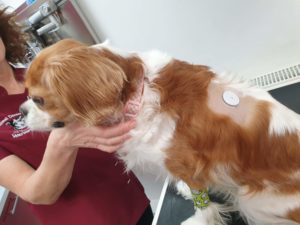Diabetes, specifically diabetes mellitus or “sugar diabetes”, can affect our dogs’ and cats’ health just as it can affect our own. A diagnosis of diabetes in your pet may seem daunting, but it can be very manageable in many cases by working closely with us to decide on the best treatment and monitoring plan to suit you and your pet.
Causes of diabetes mellitus
Diabetes mellitus is a disorder in which the level of glucose in the blood becomes excessively high. This occurs as a result of abnormalities involving the hormone insulin, which is produced by the pancreas. Insulin enables the cells of the body to take in glucose which is used for energy. In diabetic patients, either the pancreas fails to produce sufficient insulin, or the cells of the body do not respond to the insulin appropriately. This prevents glucose from being taken into the cells, meaning that it remains in the bloodstream.
There are multiple predisposing factors for the development of diabetes including:
- Genetics or breed
- Obesity
- Other diseases e.g. Cushing’s disease or pancreatitis
- Medications such as steroids
- Pregnancy or phase of reproductive cycle in females
Clinical signs
The most common clinical signs of diabetes mellitus in cats and dogs are:
- Excessive drinking
- Excessive urination
- Weight loss
- Weakness or fainting
- Cataract formation (dogs)
Recurrent secondary bacterial infections are also common in diabetic patients, such as cystitis or skin infections.
A potentially dangerous complication associated with diabetes is diabetic ketoacidosis. This occurs because the cells of the body cannot take in glucose and have to use an alternative energy source in the form of fatty acids. The metabolism of fatty acids produces ketones which can cause life-threatening illness if they build up in the blood. Signs include vomiting, severe lethargy or collapse, sweet-smelling breath and dehydration. This is a life-threatening emergency situation so contact us immediately if your pet shows these symptoms.
Diagnosis and treatment options
If we suspect diabetes in your pet, the diagnosis can be confirmed using blood tests to check for a high blood glucose level, and a urine sample to look for glucose in the urine. We may also advise further tests to rule out other possible problems.
Several treatment and management options are available and it is often necessary to use several of these together to achieve the best results:
Treatment of concurrent diseases
It is essential to rule out or treat any other health problems that may be contributing to the condition and making it difficult to stabilise the diabetes, such as Cushing’s disease, pancreatitis or infections. Assessment for these will require further blood tests and in some cases other investigations, such as an ultrasound scan.
Weight management and dietary changes
Some pets may be underweight following a diagnosis of diabetes, as the condition tends to cause weight loss despite a normal or increased appetite. In these patients, a plan for an appropriate level of weight gain will be made.
On the other hand, overweight patients will benefit from a weight reduction plan in order to reach and maintain a healthy body condition. An appropriate diet and exercise regime can be produced to suit your pet and lifestyle. This can be discussed with and overseen by our vets and nurses.
Specific dietary changes or a prescription diabetic food are often advised. These aim to provide higher levels of dietary protein and fibre with a reduced amount of starch, which helps to stabilise your pet’s blood glucose levels and maintain healthy muscle mass. It is important to maintain a consistent daily feeding regime which should include sticking to regular timings of meals and portions provided.
Neutering female diabetic pets
Changes associated with the hormonal cycle of intact female diabetic pets can affect the stability of their condition, and pregnancy can have a similar effect. It is therefore helpful to neuter (spay) your female diabetic pet once their condition has been stabilised.
Insulin therapy
Insulin injections are used to treat most cases of diabetes in dogs and cats. Injections are given under the skin, either with a needle and syringe or using a pen-type device. They are usually given twice a day or sometimes once a day. Once your pet has been diagnosed with diabetes, we will show you how to administer the insulin and explain how much to give.
It is very important to look out for signs of low blood glucose (hypoglycaemia) during treatment. Hypoglycaemia can occur if the dose of insulin given is too high, if your pet misses a meal, if they exercise excessively, or if they are unwell for another reason. Typical signs include weakness, wobbliness, collapse and seizures. If any of these signs are seen, a small amount of glucose gel or honey should be applied to your pet’s gums and you should phone us immediately. If your pet is alert enough to swallow, you can offer a small amount of food.
Oral hypoglycaemic agents
Some diabetic patients, particularly cats, may benefit from additional or alternative medications, for example glipizide, which is given orally to help reduce the blood glucose level.
Monitoring response to treatment
The first few weeks or months of treatment will involve regular monitoring, including check-ups at the practice, blood samples and urine tests. This enables us to assess how well your pet is responding to their treatment plan and to make any necessary adjustments. Once we are happy with your pet’s medication dose and they are doing well at home, we can reduce how often they need to be checked.
It can also be useful to monitor your pet’s blood glucose levels and trends at home using a glucometer or a continuous monitoring system such as the Libre sensor. The results can be reported back to us to help with monitoring and dosage adjustment.
Below you can see one of our patients, the beautiful Lilly, having her Libre sensor fitted by our team. Lilly adjusted well to the sensor and was enjoying the festive period shortly after.


Consistency is essential when it comes to management of diabetes in our pets. Sticking to a strict feeding, exercise and medication schedule helps to keep their glucose levels stable and minimise the associated clinical signs, keeping them well-managed and helping to maintain a good quality of life.


